Google’s Smart Bidding has evolved over the years to have a better understanding of what works for many PPC accounts. It wasn’t too long ago that advertisers preferred manual bidding outright.
Smart Bidding is now commonly used and much more effective than ever before — over 92% of Google Ads accounts linked to Optmyzr use Smart Bidding in at least one campaign.
But while Smart Bidding strategies aim to drive volume-based KPIs such as clicks or conversions, not all conversions are created equal.
With bid strategies like Target ROAS and Maximize Conversion Value, there’s a much stronger case to bid for value rather than volume.
The Optmyzr suite currently has three tools to help advertisers and agencies implement these strategies effectively and easily.
In this article, you’ll learn:
- What these tools are
- How to use them
- Common use cases
- Best practices to maximize effectiveness
Create training data using Segment Scorer
The Segment Scorer lets you easily rate segments from your online audiences based on their value to your business. These ratings should be based not on Google metrics like click-through rate, but on how they perform after converting.
With these scores, you create training data for Optmyzr to suggest the best Conversion Value Rules for your campaigns. Conversion Value Rules are similar to bid adjustments for Smart Bidding and put your scores in a format that Google can understand.
Go to Segment Scorer
Let’s look at an example of this in practice. When you’re asked to score a segment like the one below (United States), you first need to analyze the value of this segment to your or your client’s business:
- Are people from the US more likely to buy from you?
- Do they return fewer products or have a shorter sales cycle?
- Is the average order value higher among US customers?

Based on the angles important to the business, give it a score between 1 and 5 with 5 being the highest and 1 being the lowest.
You can score segments from five categories in this tool: City, Region, Country, Device, and Audience.
Adjust conversion values using Optimize Value Rules
The Optimize Value Rules tool suggests conversion value rules based on your data inputs from the Segment Scorer. Conversion Value Rules let you better express the importance of your conversions as they relate to your business.
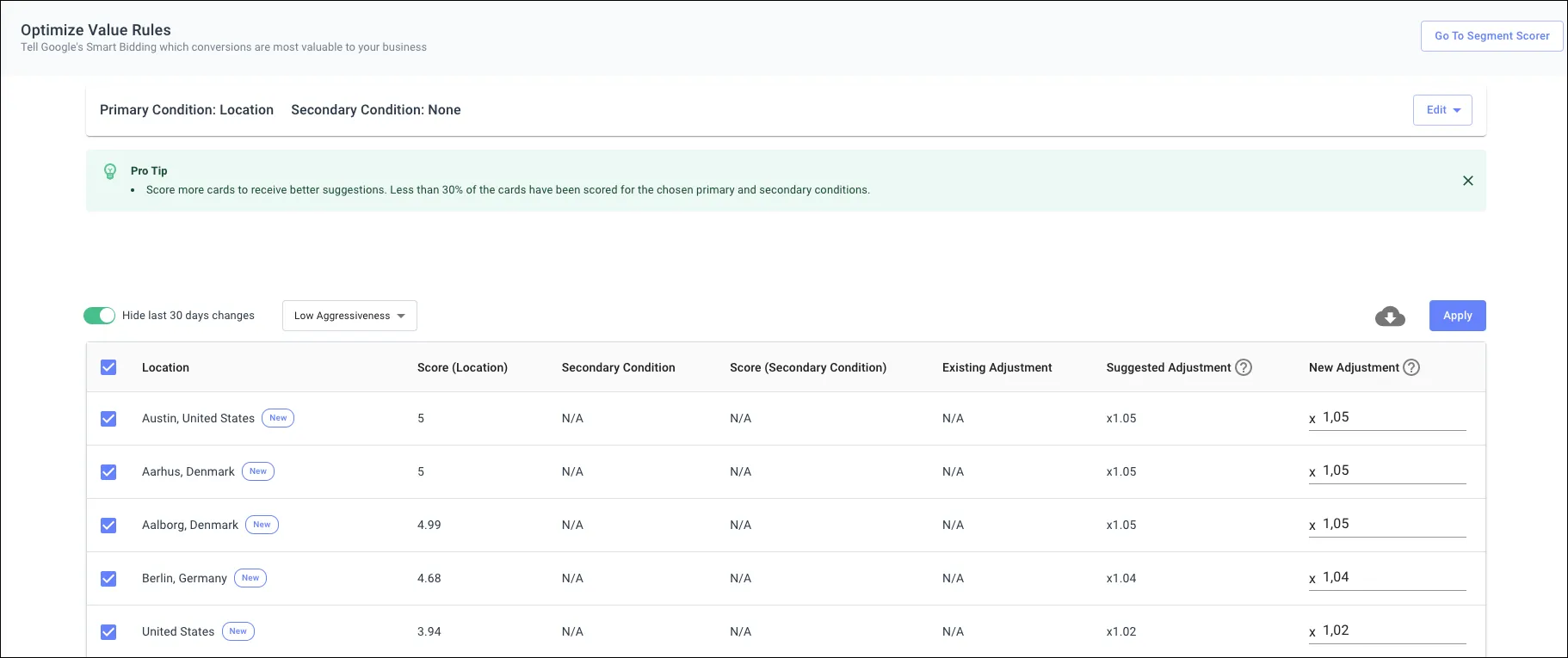
This tool bridges the gap between your business knowledge and Google’s ability to use that knowledge to get you the most profitable conversions.
Go to Optimize Value Rules
The magnitude of a suggested adjustment depends on the scores for the primary and secondary segments. However, you can always change the adjustment for each entry by editing the fields in the ‘New Adjustment’ column.
Note: Before applying adjustments, read up on the common pitfalls of value-based bidding so you can better monitor performance.
Discover insights using Segment Explorer
The Segment Explorer lets you visualize your Google Analytics audiences’ performance by multiple dimensions in Optmyzr.
Many times in Google Analytics, it’s difficult to segment and visualize multiple audiences together. But with Segment Explorer, getting those insights becomes straightforward.
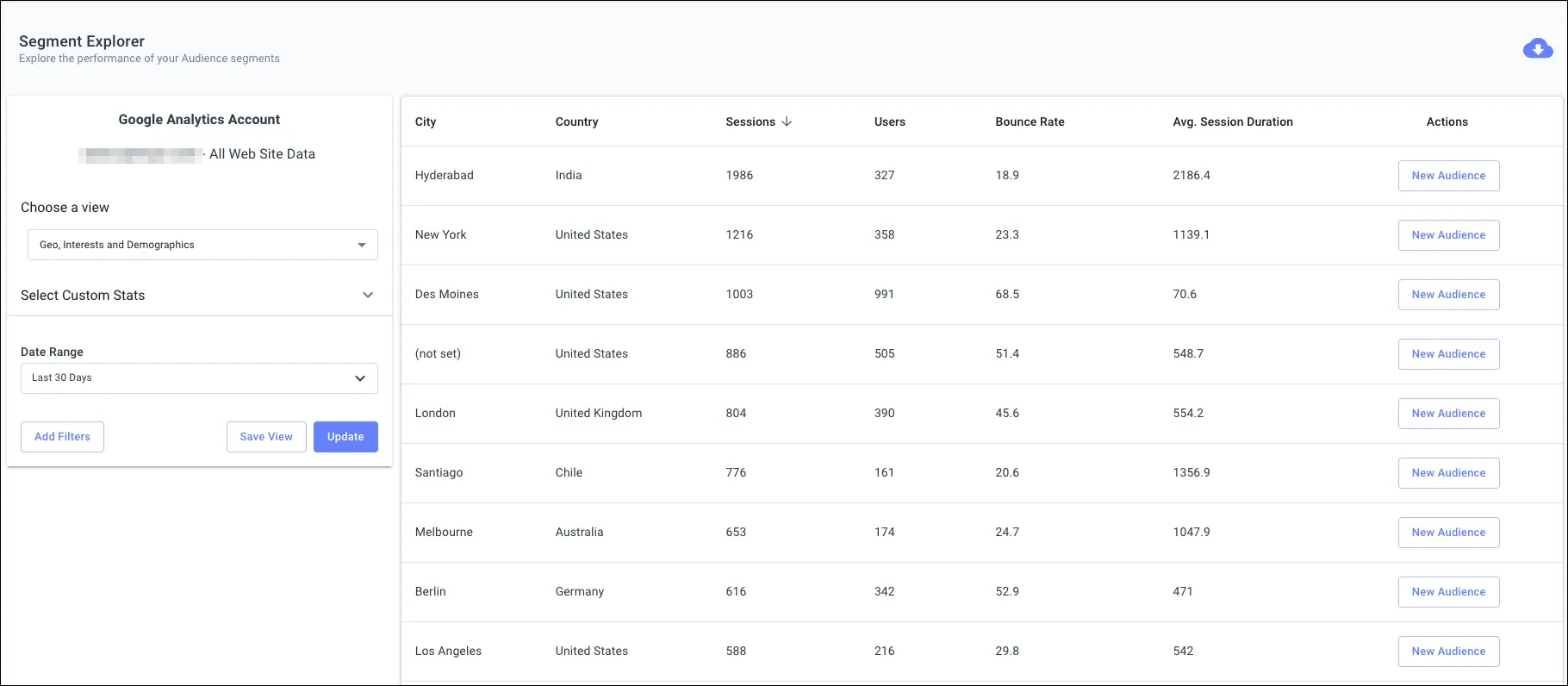
Go to Segment Explorer
Check out the performance of multiple audiences in terms of behavior, geography, and demographics — all at once. This lets you create targeted audiences for your Google Ads campaigns, faster than you could do manually.
How conversion values can vary: use cases
Let’s look at how different industries might use these tools to optimize the ROI of their ad spend. Remember that after Google reports a conversion, its final value to a business varies based on several factors including location, ticket size, product type, and more.
Home Services
Example: Roofing
Google conversion event: Lead gen form completed
What can happen afterward:
- Roofing company contacts the lead to schedule a free estimate
- Estimator meets the prospect
- Prospect reviews the estimate
- Prospect becomes a paying customer
What can affect the final value:
- Some zip codes have bigger houses. Bigger houses mean bigger roofs. And bigger roofs mean higher average project values.
- There are different types of roofing materials that vary with geography and customer preferences. For instance, customers in warmer locations like Los Angeles may prefer solar roofing. Different materials have different margins, making a job more or less profitable than usual.
Education
Example: University
Google conversion event: Lead gen form completed
What can happen afterward:
- College contacts applicant to discuss the education program
- Applicant may apply for financial assistance
- Applicant is admitted and becomes a paying customer
What can affect the final value:
- Depending on the area of study the prospect indicates, it can be a longer or shorter program and have a different total cost.
- Applicant proximity to campus impacts the chance they attend virtual or in-person programs, which may have different associated costs like room and board.
- Preferred degree may make them more or less likely to get a high-paying job, thus influencing their ability to make charitable donations to the university after they graduate.
Ecommerce
Example: Cosmetics
Google conversion event: Purchase/checkout
What can happen afterward:
- Order is returned for a refund, either in part or in whole
- Customer buys additional products of equal or greater value
What can affect the final value:
- Someone who buys a big bottle of shampoo will be less likely to be a repeat customer in the short term than someone who buys a trial size of several shampoos.
- Some customers will return more of their purchases. For example, different demographics may correlate with higher impulse purchase behavior i.e. they buy several products but return most of them.
Among all of Google’s advertising products, Performance Max is the most comprehensive example of automation yet. It promises a new way to advertise across all of Google’s channels, which also means fully automated bidding and budget allocation.
This calls for a new approach to ROI optimization that’s less about pushing buttons or turning dials and more about feeding the right first-party data that’s not accessible to Google or your campaign.
If you’re an ecommerce clothing store, that data can be detailed stock information like availability per size or color, margin, sell-through rate, return rate, etc.
Feeding this data to Google along with Conversion Value Rules offers you better control over your Performance Max campaigns. A good strategy here would be running Maximize Conversion Value with tROAS.
Best practices for ROI optimization
We suggest the following best practices to produce optimal results when using a value-based bidding strategy.
- Score your segments based on their ultimate value to the business, not according to metrics or KPIs that Google can easily see.
- Check your campaign performance after four weeks of making adjustments. The Smart Bidding algorithms need some time to learn what the right traffic looks like to you.
- Re-score your segments in the Segment Scorer if there are changes in your business priorities (like a discontinued product), or when you have to optimize your campaign performance (a product that isn’t moving). We still recommend spacing adjustments four weeks apart.
- Be sure to set your bidding strategy to Maximize Conversion Value (with or without a target ROAS) so that Smart Bidding can take different conversion values into account.
Solutions to common concerns around ROI Optimization
Errors in reporting due to ‘Adjusted Conversion Value’
When you work with Value Rules, there will be differences between your original conversion values and adjusted conversion values. This leads to discrepancies in reporting.
To overcome that, we added ‘Unadjusted Conversion Value’ to the ‘KPIs’, ‘Summary’, ‘Top Campaigns’, and ‘Performance Comparison’ widgets in our single account report. When you’re reporting metrics to your clients, you can clearly communicate the actual conversion value and the adjustment made to it.
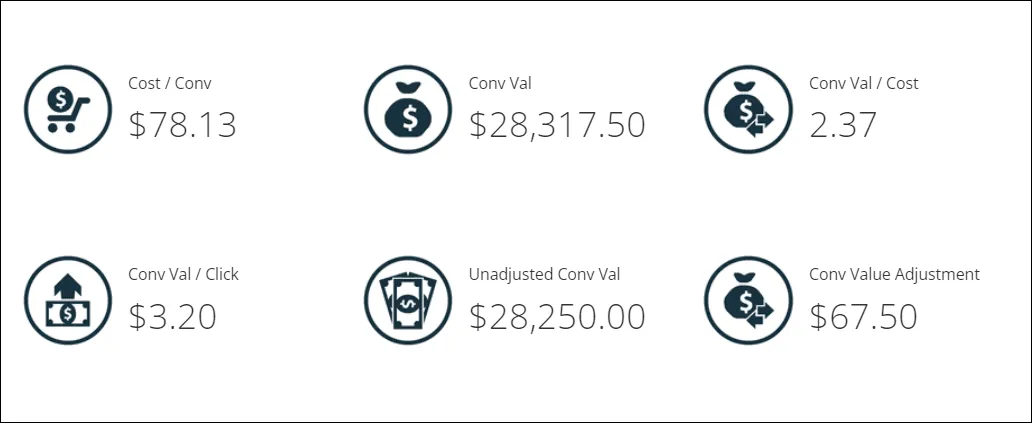
Knowledge gap between you and your client
We’ve heard from some customers — especially agencies — that it can be challenging to obtain scores for the Segment Scorer. To make that easier, we’ve created a template you can share with clients or stakeholders to fill out.
In the ‘Start Scoring Segments’ dropdown, select ‘Bulk Score Segments’. You can download the template, add the scores and then upload it back to the tool.

This template can serve you in two ways:
- You can score multiple segments at once without the need to score a large set of scoring cards one after another.
- You can share this template with your clients requesting them to score the segments based on their business goals. This bridges the knowledge gap between you and your client, ultimately bringing more accurate Value Rules suggestions for your Google Ads account while respecting a client’s need for privacy.
Data is your most valuable asset
ROI optimization is the next evolution of account optimization after a conversion-based strategy. But for any optimization to work, you must collect the right data to enable smarter decisions from ad platforms like Google.
Unique business data is your most powerful asset, and the optimization tools that we’ve built can help you make the best use of that data in a smooth process.
Why optimize for numbers when you can optimize for actual profitability?
Get started with a 14-day free trial today.
When the decisions you make impact thousands of people and businesses, you have to take them seriously – no matter how seemingly minor. Our choices at Optmyzr play a considerable role in our customers’ success with Google Ads and other platforms, so we’re always looking for new ways to make PPC life easier and less stressful.
An example of this is value-based bid strategies – one of the techniques rising in popularity with both end advertisers and performance agency marketers. After all, who doesn’t want to maximize the value of their conversions?
Sadly, too many “solutions” simply repackage what you can do in Google Ads which, for us, isn’t good enough. We don’t think advertisers should pay for a re-skinned interface or marginally better experience.
In our last article on the subject, we detailed everything you need to know about value-based bidding in Google Ads – what it is, how it works, how to get started, and what not to do. And now, we’re going to show you the capabilities in Optmyzr that let you take advantage of value-based bid strategies.
Our product design philosophy is centered around three principles: relevance, scale, and control. Each of these is about giving you the tools to improve the performance of your ad campaigns, your team, and your business.
- Relevance: Complement, enhance, and speed up what Google already lets your team do.
- Scale: Deliver capabilities that work for businesses and advertisers of all shapes, sizes, and goals.
- Control: Give you the last word on how your accounts behave and perform, whether by automation or manual intervention
Here are some of the ways we apply that thinking to value-based bid strategies and Smart Bidding.
Mine insights with Segment Explorer
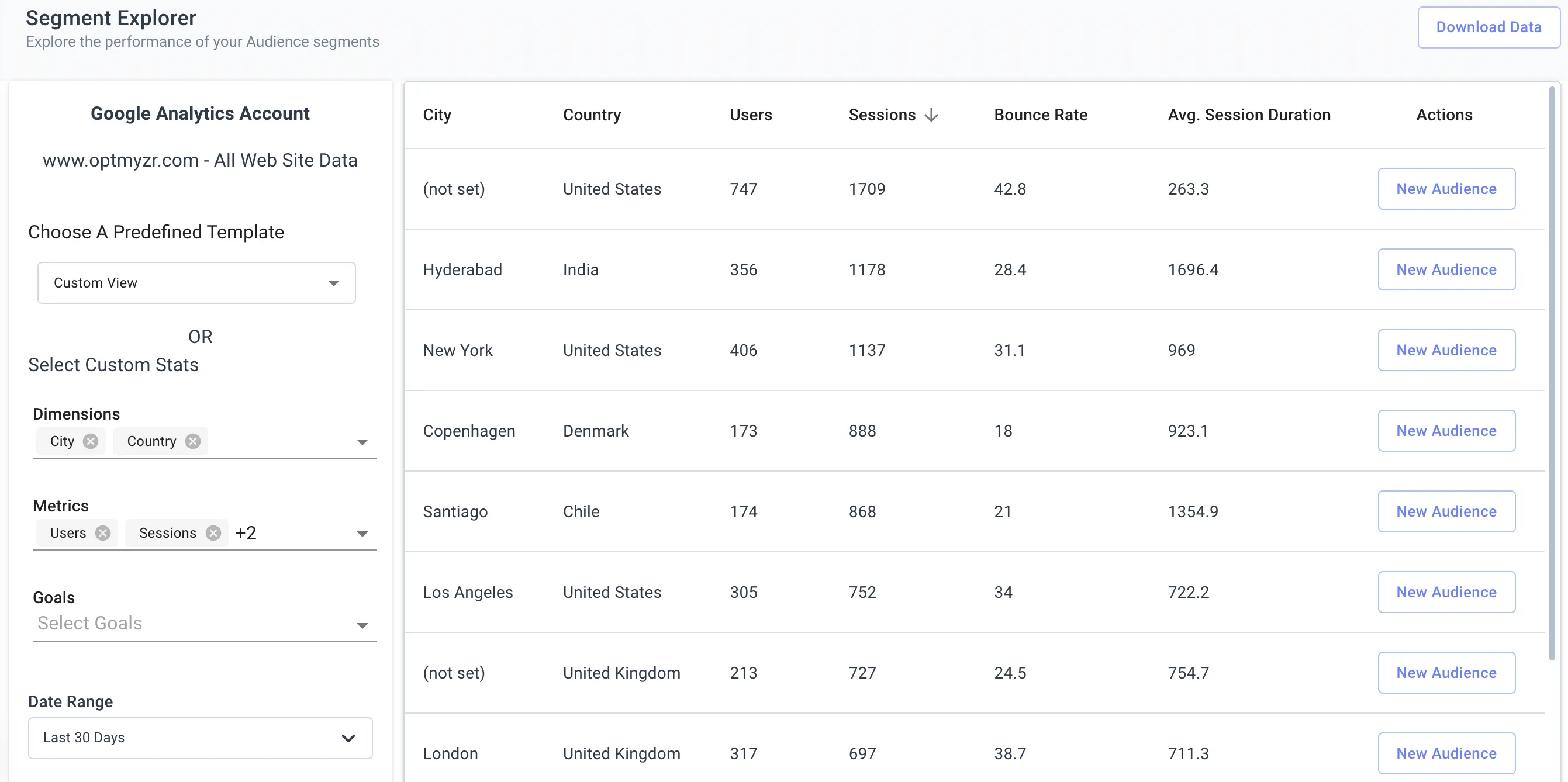
What it does: Segment Explorer lets you view the performance metrics of any connected Google Analytics account for multiple dimensions combined at once.
What it solves: In the Google Analytics interface, it’s difficult to see performance data for multiple audience segments at once. Segment Explorer makes it simple to add different audience segments to a view. Please note that not all segment combinations (dimensions) are allowed through the API; selecting an invalid combination will render an error message.
How to use it: See performance data for a group of dimensions – demographics, geographies, Interests, technology, etc – to reveal which combinations tend to perform better.
Optmyzr customer? Go there now.
Assign values with Segment Scorer
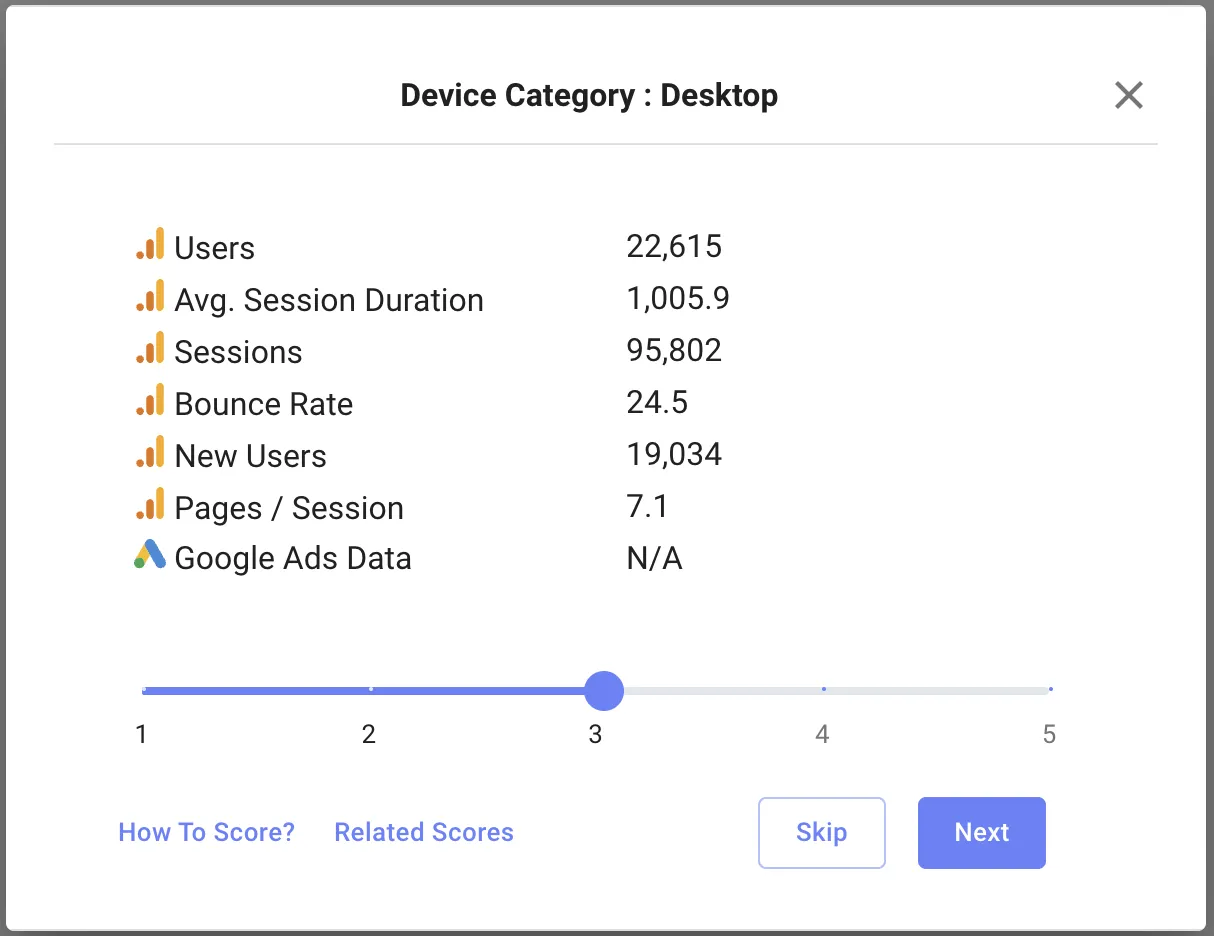
What it does: Segment Scorer lets you rate segments by different geography, device, or audiences – for example, males aged 21-35 in the US or visitors spending $100 or more – based on how valuable they are to your business versus the average conversion.
How it helps: By scoring segments aligned with the business values of your conversions, you can feed data into Google via Conversion Value Rules to further optimize Smart Bidding performance. It’s important that these values be based on context not observed or captured in Google Ads e.g. margin of a shopping transaction, deal size of a commercial business lead, or customer lifetime value.
How to use it: You need to have a Google Ads account connected, and while an associated Google Analytics account isn’t necessary, it certainly helps. We’ll show you different segments, and you rate them from 1-5 based on their value to your business compared to the average conversion. Your entire team can rate segments.
Optmyzr customer? Go there now.
Adjust bids using Optimize Value Rules

What it does: This tool recommends and adjusts the magnitude of bids for Conversion Value Rules based on your ratings from Segment Scorer. Conversion Value Rules let you better express the value of conversions as they relate to your business. Smart Bidding uses these to adjust auction-time bids for leads based on geography, device, or audience (first-party or Google) in real time, and uses the resulting performance data to further improve the quality of your leads and conversions.
What it solves: Optimize Value Rules bridges the gap between your business knowledge and Google’s ability to put that knowledge to use maximizing the value of your conversions. Our tool lets you adjust the value of your bids based on Segment Scorer-assigned values, depending one how aggressively you want to bid on these differences.
How to use it: Rating your segments in Segment Scorer is a prerequisite to getting adjustment recommendations in Optimize Value Rules. Once you apply them, avoid the most common pitfalls as your monitor performance. Be sure to set your bidding strategy to Maximize Conversion Value (with or without a target ROAS) so that Smart Bidding can take the values into account.
Optmyzr customer? Go there now.
Customize anything with the Rule Engine

What it does: The Rule Engine lets you build and automate custom workflows in Google Ads, making it one of our most popular tools. Optmyzr customers use the Rule Engine to achieve a variety of standard PPC goals – for example, cutting out wasted ad spend or excluding certain components – improve the efficiency of their current processes, and apply creative solutions like adjusting bids based on the weather.
What it solves: Bidding is just one component of the advertising ecosystem. Even if you hand this responsibility to Smart Bidding (with oversight), you still have plenty of other opportunities for optimization. With the Rule Engine, you can automate any monitoring or optimization process that goes with your bid strategy.
How to use it: The Rule Engine is built on conditional logic – if x happens, then perform y action. Even in our pre-built strategies, you have complete control over the triggers and resulting actions.
Optmyzr customer? Go there now.
Disclaimer: Our Rule Engine is different from Google’s Conversion Value Rules, even though both use conditional logic (if x, then y). Rule Engine lets you build and automate rules for any process or workflow. Google’s Conversion Value Rules allows you to better express the value of different customers based on geography, device, or audience.
Test faster and better with Campaign Experiments
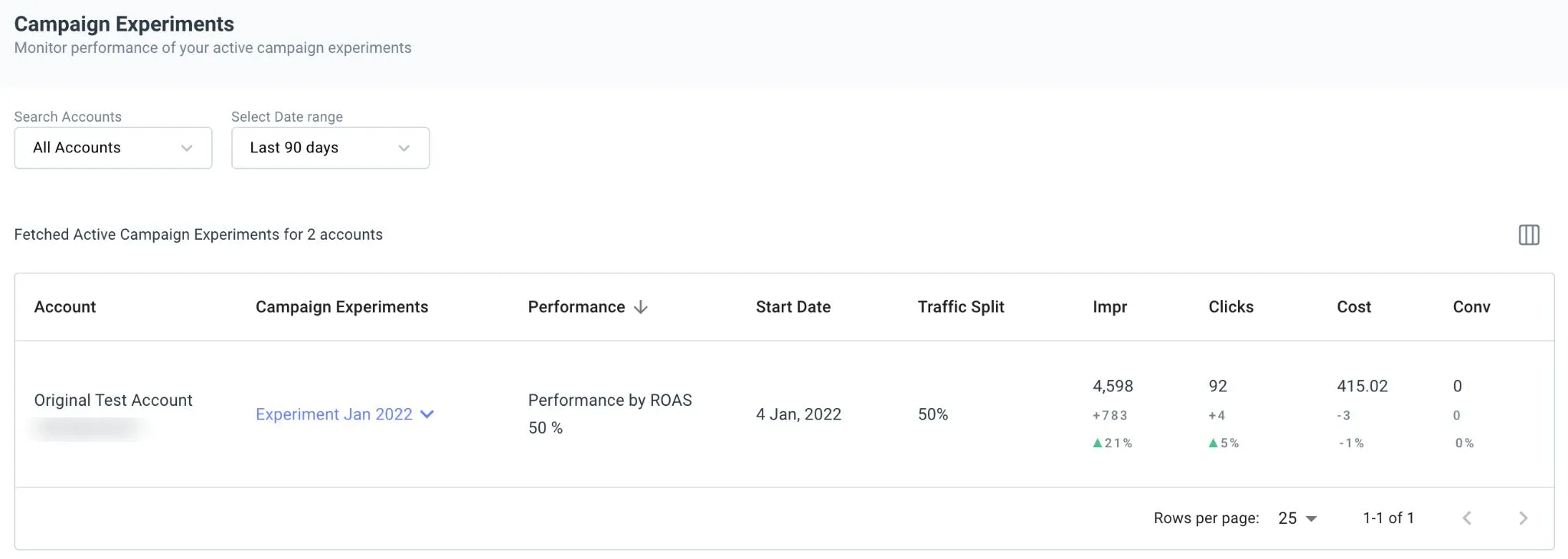
What it does: Campaign Experiments is a powerful dashboard in Optmyzr that shows you every single experiment you’re running in search of the perfectly optimized campaign.
What it solves: Running multiple simultaneous tests on your campaigns is often necessary in order to find the conditions that lead to the highest conversion value for your budget. But it can be difficult to keep track of them, leading to overextended experiments and lost optimization opportunities.
How to use it: Pick an account and date range, and the Campaign Experiments tool will show you all the active tests currently running across all campaigns. You can see start dates, traffic splits, and key metric data from a single screen.
Optmyzr customer? Go there now.
Learn, study, and prepare
Things are changing fast in advertising land. You don’t want to be caught by surprise when the platforms make new changes, so use our content library to navigate these new changes. Here’s some select reading and viewing:
Offline Conversion Tracking Just Got a Whole Lot Easier with Enhanced Conversions from Google
3 Ways to Improve Smart Bidding Performance on Google Ads
How to Win Quality Leads with Google Ads Smart Bidding and Offline Conversions
Automation Layering: The PPC Expert’s New Secret Sauce
Optmyzr’s Guide to Google Ads Performance Max Campaigns
Put it to the test with our free trial
Thousands of advertisers and PPC marketers use Optmyzr to manage over $4 billion in ad spend every year. From boutique and network agencies to some of the most recognized brands in the world, our platform scales well across all types of business models and client verticals.
See what else Optmyzr can enable for your PPC team or business and, when you’re ready, get started with our 14-day free trial (includes everything except automation).
Not only will you get the resources you need to start testing these tools and more, our team will be on hand to answer questions and provide any support we can.
Regular Pages
Google’s Smart Bidding has evolved over the years to have a better understanding of what works for many PPC accounts. It wasn’t too long ago that advertisers preferred manual bidding outright.
Smart Bidding is now commonly used and much more effective than ever before — over 92% of Google Ads accounts linked to Optmyzr use Smart Bidding in at least one campaign.
But while Smart Bidding strategies aim to drive volume-based KPIs such as clicks or conversions, not all conversions are created equal.
With bid strategies like Target ROAS and Maximize Conversion Value, there’s a much stronger case to bid for value rather than volume.
The Optmyzr suite currently has three tools to help advertisers and agencies implement these strategies effectively and easily.
In this article, you’ll learn:
- What these tools are
- How to use them
- Common use cases
- Best practices to maximize effectiveness
Create training data using Segment Scorer
The Segment Scorer lets you easily rate segments from your online audiences based on their value to your business. These ratings should be based not on Google metrics like click-through rate, but on how they perform after converting.
With these scores, you create training data for Optmyzr to suggest the best Conversion Value Rules for your campaigns. Conversion Value Rules are similar to bid adjustments for Smart Bidding and put your scores in a format that Google can understand.
Go to Segment Scorer
Let’s look at an example of this in practice. When you’re asked to score a segment like the one below (United States), you first need to analyze the value of this segment to your or your client’s business:
- Are people from the US more likely to buy from you?
- Do they return fewer products or have a shorter sales cycle?
- Is the average order value higher among US customers?

Based on the angles important to the business, give it a score between 1 and 5 with 5 being the highest and 1 being the lowest.
You can score segments from five categories in this tool: City, Region, Country, Device, and Audience.
Adjust conversion values using Optimize Value Rules
The Optimize Value Rules tool suggests conversion value rules based on your data inputs from the Segment Scorer. Conversion Value Rules let you better express the importance of your conversions as they relate to your business.

This tool bridges the gap between your business knowledge and Google’s ability to use that knowledge to get you the most profitable conversions.
Go to Optimize Value Rules
The magnitude of a suggested adjustment depends on the scores for the primary and secondary segments. However, you can always change the adjustment for each entry by editing the fields in the ‘New Adjustment’ column.
Note: Before applying adjustments, read up on the common pitfalls of value-based bidding so you can better monitor performance.
Discover insights using Segment Explorer
The Segment Explorer lets you visualize your Google Analytics audiences’ performance by multiple dimensions in Optmyzr.
Many times in Google Analytics, it’s difficult to segment and visualize multiple audiences together. But with Segment Explorer, getting those insights becomes straightforward.

Go to Segment Explorer
Check out the performance of multiple audiences in terms of behavior, geography, and demographics — all at once. This lets you create targeted audiences for your Google Ads campaigns, faster than you could do manually.
How conversion values can vary: use cases
Let’s look at how different industries might use these tools to optimize the ROI of their ad spend. Remember that after Google reports a conversion, its final value to a business varies based on several factors including location, ticket size, product type, and more.
Home Services
Example: Roofing
Google conversion event: Lead gen form completed
What can happen afterward:
- Roofing company contacts the lead to schedule a free estimate
- Estimator meets the prospect
- Prospect reviews the estimate
- Prospect becomes a paying customer
What can affect the final value:
- Some zip codes have bigger houses. Bigger houses mean bigger roofs. And bigger roofs mean higher average project values.
- There are different types of roofing materials that vary with geography and customer preferences. For instance, customers in warmer locations like Los Angeles may prefer solar roofing. Different materials have different margins, making a job more or less profitable than usual.
Education
Example: University
Google conversion event: Lead gen form completed
What can happen afterward:
- College contacts applicant to discuss the education program
- Applicant may apply for financial assistance
- Applicant is admitted and becomes a paying customer
What can affect the final value:
- Depending on the area of study the prospect indicates, it can be a longer or shorter program and have a different total cost.
- Applicant proximity to campus impacts the chance they attend virtual or in-person programs, which may have different associated costs like room and board.
- Preferred degree may make them more or less likely to get a high-paying job, thus influencing their ability to make charitable donations to the university after they graduate.
Ecommerce
Example: Cosmetics
Google conversion event: Purchase/checkout
What can happen afterward:
- Order is returned for a refund, either in part or in whole
- Customer buys additional products of equal or greater value
What can affect the final value:
- Someone who buys a big bottle of shampoo will be less likely to be a repeat customer in the short term than someone who buys a trial size of several shampoos.
- Some customers will return more of their purchases. For example, different demographics may correlate with higher impulse purchase behavior i.e. they buy several products but return most of them.
Among all of Google’s advertising products, Performance Max is the most comprehensive example of automation yet. It promises a new way to advertise across all of Google’s channels, which also means fully automated bidding and budget allocation.
This calls for a new approach to ROI optimization that’s less about pushing buttons or turning dials and more about feeding the right first-party data that’s not accessible to Google or your campaign.
If you’re an ecommerce clothing store, that data can be detailed stock information like availability per size or color, margin, sell-through rate, return rate, etc.
Feeding this data to Google along with Conversion Value Rules offers you better control over your Performance Max campaigns. A good strategy here would be running Maximize Conversion Value with tROAS.
Best practices for ROI optimization
We suggest the following best practices to produce optimal results when using a value-based bidding strategy.
- Score your segments based on their ultimate value to the business, not according to metrics or KPIs that Google can easily see.
- Check your campaign performance after four weeks of making adjustments. The Smart Bidding algorithms need some time to learn what the right traffic looks like to you.
- Re-score your segments in the Segment Scorer if there are changes in your business priorities (like a discontinued product), or when you have to optimize your campaign performance (a product that isn’t moving). We still recommend spacing adjustments four weeks apart.
- Be sure to set your bidding strategy to Maximize Conversion Value (with or without a target ROAS) so that Smart Bidding can take different conversion values into account.
Solutions to common concerns around ROI Optimization
Errors in reporting due to ‘Adjusted Conversion Value’
When you work with Value Rules, there will be differences between your original conversion values and adjusted conversion values. This leads to discrepancies in reporting.
To overcome that, we added ‘Unadjusted Conversion Value’ to the ‘KPIs’, ‘Summary’, ‘Top Campaigns’, and ‘Performance Comparison’ widgets in our single account report. When you’re reporting metrics to your clients, you can clearly communicate the actual conversion value and the adjustment made to it.

Knowledge gap between you and your client
We’ve heard from some customers — especially agencies — that it can be challenging to obtain scores for the Segment Scorer. To make that easier, we’ve created a template you can share with clients or stakeholders to fill out.
In the ‘Start Scoring Segments’ dropdown, select ‘Bulk Score Segments’. You can download the template, add the scores and then upload it back to the tool.

This template can serve you in two ways:
- You can score multiple segments at once without the need to score a large set of scoring cards one after another.
- You can share this template with your clients requesting them to score the segments based on their business goals. This bridges the knowledge gap between you and your client, ultimately bringing more accurate Value Rules suggestions for your Google Ads account while respecting a client’s need for privacy.
Data is your most valuable asset
ROI optimization is the next evolution of account optimization after a conversion-based strategy. But for any optimization to work, you must collect the right data to enable smarter decisions from ad platforms like Google.
Unique business data is your most powerful asset, and the optimization tools that we’ve built can help you make the best use of that data in a smooth process.
Why optimize for numbers when you can optimize for actual profitability?
Get started with a 14-day free trial today.
When the decisions you make impact thousands of people and businesses, you have to take them seriously – no matter how seemingly minor. Our choices at Optmyzr play a considerable role in our customers’ success with Google Ads and other platforms, so we’re always looking for new ways to make PPC life easier and less stressful.
An example of this is value-based bid strategies – one of the techniques rising in popularity with both end advertisers and performance agency marketers. After all, who doesn’t want to maximize the value of their conversions?
Sadly, too many “solutions” simply repackage what you can do in Google Ads which, for us, isn’t good enough. We don’t think advertisers should pay for a re-skinned interface or marginally better experience.
In our last article on the subject, we detailed everything you need to know about value-based bidding in Google Ads – what it is, how it works, how to get started, and what not to do. And now, we’re going to show you the capabilities in Optmyzr that let you take advantage of value-based bid strategies.
Our product design philosophy is centered around three principles: relevance, scale, and control. Each of these is about giving you the tools to improve the performance of your ad campaigns, your team, and your business.
- Relevance: Complement, enhance, and speed up what Google already lets your team do.
- Scale: Deliver capabilities that work for businesses and advertisers of all shapes, sizes, and goals.
- Control: Give you the last word on how your accounts behave and perform, whether by automation or manual intervention
Here are some of the ways we apply that thinking to value-based bid strategies and Smart Bidding.
Mine insights with Segment Explorer

What it does: Segment Explorer lets you view the performance metrics of any connected Google Analytics account for multiple dimensions combined at once.
What it solves: In the Google Analytics interface, it’s difficult to see performance data for multiple audience segments at once. Segment Explorer makes it simple to add different audience segments to a view. Please note that not all segment combinations (dimensions) are allowed through the API; selecting an invalid combination will render an error message.
How to use it: See performance data for a group of dimensions – demographics, geographies, Interests, technology, etc – to reveal which combinations tend to perform better.
Optmyzr customer? Go there now.
Assign values with Segment Scorer

What it does: Segment Scorer lets you rate segments by different geography, device, or audiences – for example, males aged 21-35 in the US or visitors spending $100 or more – based on how valuable they are to your business versus the average conversion.
How it helps: By scoring segments aligned with the business values of your conversions, you can feed data into Google via Conversion Value Rules to further optimize Smart Bidding performance. It’s important that these values be based on context not observed or captured in Google Ads e.g. margin of a shopping transaction, deal size of a commercial business lead, or customer lifetime value.
How to use it: You need to have a Google Ads account connected, and while an associated Google Analytics account isn’t necessary, it certainly helps. We’ll show you different segments, and you rate them from 1-5 based on their value to your business compared to the average conversion. Your entire team can rate segments.
Optmyzr customer? Go there now.
Adjust bids using Optimize Value Rules

What it does: This tool recommends and adjusts the magnitude of bids for Conversion Value Rules based on your ratings from Segment Scorer. Conversion Value Rules let you better express the value of conversions as they relate to your business. Smart Bidding uses these to adjust auction-time bids for leads based on geography, device, or audience (first-party or Google) in real time, and uses the resulting performance data to further improve the quality of your leads and conversions.
What it solves: Optimize Value Rules bridges the gap between your business knowledge and Google’s ability to put that knowledge to use maximizing the value of your conversions. Our tool lets you adjust the value of your bids based on Segment Scorer-assigned values, depending one how aggressively you want to bid on these differences.
How to use it: Rating your segments in Segment Scorer is a prerequisite to getting adjustment recommendations in Optimize Value Rules. Once you apply them, avoid the most common pitfalls as your monitor performance. Be sure to set your bidding strategy to Maximize Conversion Value (with or without a target ROAS) so that Smart Bidding can take the values into account.
Optmyzr customer? Go there now.
Customize anything with the Rule Engine

What it does: The Rule Engine lets you build and automate custom workflows in Google Ads, making it one of our most popular tools. Optmyzr customers use the Rule Engine to achieve a variety of standard PPC goals – for example, cutting out wasted ad spend or excluding certain components – improve the efficiency of their current processes, and apply creative solutions like adjusting bids based on the weather.
What it solves: Bidding is just one component of the advertising ecosystem. Even if you hand this responsibility to Smart Bidding (with oversight), you still have plenty of other opportunities for optimization. With the Rule Engine, you can automate any monitoring or optimization process that goes with your bid strategy.
How to use it: The Rule Engine is built on conditional logic – if x happens, then perform y action. Even in our pre-built strategies, you have complete control over the triggers and resulting actions.
Optmyzr customer? Go there now.
Disclaimer: Our Rule Engine is different from Google’s Conversion Value Rules, even though both use conditional logic (if x, then y). Rule Engine lets you build and automate rules for any process or workflow. Google’s Conversion Value Rules allows you to better express the value of different customers based on geography, device, or audience.
Test faster and better with Campaign Experiments

What it does: Campaign Experiments is a powerful dashboard in Optmyzr that shows you every single experiment you’re running in search of the perfectly optimized campaign.
What it solves: Running multiple simultaneous tests on your campaigns is often necessary in order to find the conditions that lead to the highest conversion value for your budget. But it can be difficult to keep track of them, leading to overextended experiments and lost optimization opportunities.
How to use it: Pick an account and date range, and the Campaign Experiments tool will show you all the active tests currently running across all campaigns. You can see start dates, traffic splits, and key metric data from a single screen.
Optmyzr customer? Go there now.
Learn, study, and prepare
Things are changing fast in advertising land. You don’t want to be caught by surprise when the platforms make new changes, so use our content library to navigate these new changes. Here’s some select reading and viewing:
Offline Conversion Tracking Just Got a Whole Lot Easier with Enhanced Conversions from Google
3 Ways to Improve Smart Bidding Performance on Google Ads
How to Win Quality Leads with Google Ads Smart Bidding and Offline Conversions
Automation Layering: The PPC Expert’s New Secret Sauce
Optmyzr’s Guide to Google Ads Performance Max Campaigns
Put it to the test with our free trial
Thousands of advertisers and PPC marketers use Optmyzr to manage over $4 billion in ad spend every year. From boutique and network agencies to some of the most recognized brands in the world, our platform scales well across all types of business models and client verticals.
See what else Optmyzr can enable for your PPC team or business and, when you’re ready, get started with our 14-day free trial (includes everything except automation).
Not only will you get the resources you need to start testing these tools and more, our team will be on hand to answer questions and provide any support we can.









